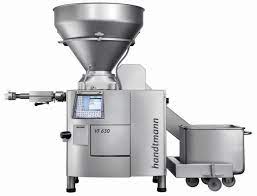
Mar . 12, 2024 14:59 Back to list
Sausage Stuffers 101
A sausage stuffer is a specialized kitchen tool used for filling sausage casings with ground meat and other ingredients. It’s an essential piece of equipment for making homemade sausages. Here’s a more detailed explanation:
Function
- Primary Purpose: The main function of a sausage stuffer is to push seasoned ground meat into sausage casings, creating a uniform and consistent sausage shape.
- Efficiency: Using a sausage stuffer is more efficient and effective than trying to stuff casings by hand or with other makeshift methods.
Types
- Manual Sausage Stuffers:
- Electric Sausage Stuffers:
- These are more advanced, with an electric motor to automate the stuffing process. They are ideal for large batches or commercial use.
Components
- Cylinder or Canister: Where the ground meat mixture is loaded.
- Plunger or Press: Used to push the meat through the machine and into the casings.
- Nozzle or Horn: The attachment through which the meat exits the stuffer and enters the casing.
- Casings: These are not part of the stuffer but are necessary for making sausages. They can be natural (intestines) or synthetic.
Usage
- The ground meat is first prepared with the desired mix of spices and seasonings.
- The meat is then loaded into the stuffer’s cylinder.
- The user operates the plunger or lever (or turns on the electric stuffer) to push the meat through the nozzle and into the casing, which is slid onto the nozzle.
- The filled casing is then twisted or tied at intervals to create individual sausages.
Benefits
- Uniformity: Provides consistent size and shape to the sausages.
- Efficiency: Significantly speeds up the sausage-making process, especially for large quantities.
- Customization: Allows for complete control over the ingredients, taste, and size of the sausages.
Maintaining a sausage stuffer is crucial to ensure its longevity and optimal performance. Here are some general maintenance tips:
Cleaning
- After Each Use:
- Disassemble the stuffer parts that come into contact with meat.
- Wash these parts with warm, soapy water. Avoid harsh chemicals that can damage the materials.
- Use a small brush to clean hard-to-reach areas.
- Rinse thoroughly with clean water.
- Drying:
- Dry all parts completely to prevent rusting, especially if the stuffer is made of metal.
- Air drying is recommended, but you can also use a clean towel.
- Sanitization:
- For additional safety, you can sanitize the parts. Use a solution of water and a small amount of bleach, or a food-safe sanitizer.
- Rinse again after sanitizing and dry thoroughly.
Lubrication
- Moving Parts: Regularly lubricate moving parts like the plunger and gears. Use food-grade mineral oil, as it’s safe for contact with food. You can lubricate.
- Nozzle: Occasionally apply a thin coat of oil to the nozzle to ensure smooth operation.
Storage
- Store the stuffer in a clean, dry place.
- Keep disassembled parts together to avoid losing them.
- Cover the stuffer to protect it from dust and other contaminants.
Regular Checks
- Inspect for Wear and Tear: Regularly check for any signs of wear, like cracks or rust.
- Check Seals and Gaskets: Ensure they are intact and replace them if they show signs of deterioration.
- Tighten Loose Parts: Occasionally, check for any loose screws or fittings and tighten them as necessary.
Usage Tips
- Avoid Overfilling: Don’t overfill the stuffer as it can put undue stress on the components.
- Proper Meat Preparation: Ensure the meat mixture isn’t too coarse, as large chunks can strain the mechanism.
Professional Maintenance
- For electric stuffers, it’s advisable to have occasional professional maintenance to check the electrical parts and motor.
Record Keeping
- Keep a record of maintenance activities, especially for commercial use, to track the condition and upkeep of the stuffer over time.
